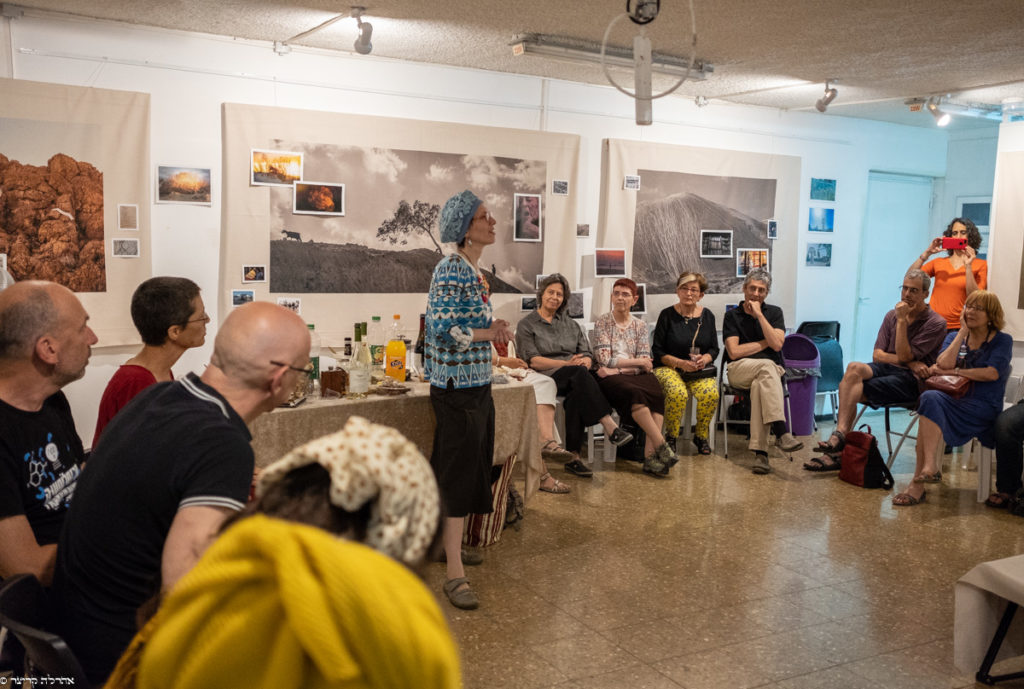אוצרת נעה לאה כהן.
הרעיון לצילומדרש נולד לפני שנתיים בעת שגלריית המקלט יחד עם אהרון קריצר הגישה יוזמה מקורית למפעל הפיס בשם זה. הרעיון היה ליצור סדנא של קבוצת צלמים חרדים בירושלים ולייצר פלטפורמה לעבודה משותפת עם מנטור צילום ולשכלל את השפה המקצועית בתנאים מתאימים.
מפעל הפיס תמך ברעיון ו'יצאנו ממצרים': קריצר יצא למסע בן מספר חודשים כדי לגבש קבוצת צלמים ובהנחייתו המסורה העמיקו בטקסטים מקראיים ומדרשיים בנושא המדבר ומתן תורה. וכך נולדה תערוכה שהיא בעלת קריאה כפולה:
התשתית מורכבת מבדים המשולים ליריעות המשכן הצמודים זה לזה ועליהם צילומים של קריצר במדבר הישראלי . אלו מהווים את הרקע, המקום והחלל שבו נתנה תורה. ברובד שמעליהם בשפה צילומית שונה, מוצגת סדרת צילומים מן השטח של חברי הסדנא המשלימים את המבט בחיבור אקטואלי ועכשווי של עשרת הדברות.
קריאה מרובדת זו הרומזת לרמות השונות שבהבנת התורה מחייבת את הצופה להיות ב'רצוא ושוב'. מצד אחד להתרחק כדי להכיל את התמונות המונומנטליות של המדבר העוצמתי. מצד שני להתכנס ולהתעמק בציווי אחד בודד וליצור היקשים, ולהעלות קושיות.
הארעיות היא המתודולוגיה הסמויה של התערוכה. היריעות- הניתנות לנשיאה ולקיפול ברגע שיתקבל הצו, הצילומים הקטנים- הניתנים להחלפה- אחוזים בסיכות נשלפות. הדימויים האקטואליים של מעשי היום יום -מחייבים את הצופה לעשות חשבון נפש תמידי, להתבונן בחייi ולמצוא את עשרת הדיברות בתוכם.
—–
A Word from the Wilderness
Aharon Kritzer
With members of the Tzilumidrash Workshop
Curator: Noa Lea Cohn
The idea for Tzilumidrash was born two years ago when the Artshelter Gallery together with Aharon Kritzer submitted a proposal to "Mifal HaPayis" Organization. The idea was to create a workshop for Haredi photographers in Jerusalem and to form a shared platform for joint work with a photography mentor to help them upgrade their professional language.
Kritzer spent several months putting together a group of photographers, and with his dedicated guidance, they engaged Biblical texts and Midrashim on the wilderness and the Giving of the Torah. Thus was born an exhibit that can be read two ways: the infrastructure consists of material that represent the drapes of the Tabernacle abutting one another, on which are mounted on Kritzer's photos of Israeli wilderness. These provide the background, the space in which the Giving of the Torah took place. Added to that, in another language, is the display of field photographs by the workshop participants, who provide their own perspective on the current connection between the Ten Utterances and divine command.
This layered reading, which alludes to the various levels on which the Torah can be understood, requires the observer to go back and forth. On one hand he must move away to take in the monumental scale of teh desert, the space. On the other, he must come close to examine a single commandment and draw analogies, raise questions.
Transience is the exhibit's hidden methodology. The drapes are fold-able and portable the moment the command is issued; the small photographs are mounted with removable pins; the practical, everyday scenes depicted are removable – require the Jew to perform a constant internal reckoning, to be ever-ready to receive the Word above, . All this leaves the viewer with the question, "What are my Ten Utterances? What am I required to do today to fulfill this commandment?"
אבקש להתמקד בתמונת לוחות הברית כיצירה המעצבת את 'האקסיס מונדי' של חלל התערוכה. התמונה נדמית כבדיונית, כשלמעשה היא צולמה במקום ריאלי-אורבני בשונה מן המדבר.
מדובר בתקריב של פסל סביבתי בשם 'כיכר לבנה' של דני קרוון המוצב בפארק וולפסון ברמת גן משנת 1976.
תפיסתו המדרשית של קריצר תרגמה את קונסטרוקציית המלבנים הכפולה לסמל לוחות הברית ונקודת הצילום הייחודית החזירה אותם אל המדבר. רבים הדיונים הקיימים במדרש על הצורה והחומר מהם עשויות לוחות הברית. בתלמוד (בבא בתרא יד עמ' א). נאמר כי הלוחות היו רבועות ששה טפחים כל צד. בפשטות ניתן לשער כי הלוחות היו עשויים מסוג של סלע כפי שכתוב במקרא "לוחות אבן", ועל פי המיקום המשוער של הר סיני ניתן לשער שמדובר בגרניט. חלק משערים שמדובר ב "מחצב של ספיר גילה לו הקב"ה" (מדרש רבה, קהלת, פרשה ט( , יש כאלו החושבים שמדובר בלאפיס לאזולי, אבן כחולה ונדירה ועוד.
בצילום הנוכחי, קריצר הופך את לוחות הברית לבטון! ויוצר פרשנות פולמוסית לפסלים הישראליים החומריים הנוכחיים כפי שאדם ברוך כינה אותם 'פיסול חילוני' -קריצר -ללא שום עיבוד, מפיח ביצירה פרשנות רליגיוזית.
—
I wish to focus on the image of the Tablets as a work that constitutes the Axis Mundi of the exhibit space. It looks imaginary, when in fact it was photographed in an urban space, not the desert: it is a close-up of an environmental sculpture called White Square by Dani Karavan that has stood in Wolfsohn Park, Ramat Gan since 1976. Kritzer's Midrashic perspective translates the double-rectangle construction into an image of the Tablets, and the unique photographic angle returned them to the wilderness. Many discussions occur in the Midrash regarding the shape and material of the Tablets. In the Talmud (Bava Batra 14a) it is stated that they were cubical, 6 handbreadths per side. In the simplest sense we can assume they were stone, since the test calls them that, and based on the estimated location of Mt. Sinai, a likely candidate would be granite. Some surmise it was sapphire (MIdrash Rabba Kohelet 9), while others suggest lapis lazuli, but extra blue and rare. In the current photo, Kritzer transforms the Tablets into concrete! He thus creates a combative interpretation targeting modern Israeli material rtists, as Adam Baruch termed them "secular sculpture." Kritzer, without altering the
original, infuses the work with religious interpretation.


